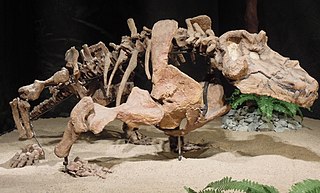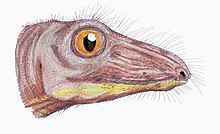Dinosaurus is an extinct genus of therapsid of controversial affinities. Its type and only species is Dinosaurus murchisonii. It is only known from a partial snout from the Permian of Russia. Its taxonomic history is intertwined with several other poorly-known Russian therapsids, particularly Rhopalodon, Brithopus, and Phthinosuchus.

Eotitanosuchus is an extinct genus of biarmosuchian therapsids whose fossils were found in the town of Ochyor in Perm Krai, Russia. It lived about 267 million years ago. The only species is Eotitanosuchus olsoni.

Biarmosuchia is an extinct clade of non-mammalian synapsids from the Permian. Biarmosuchians are the most basal group of the therapsids. They were moderately-sized, lightly built carnivores, intermediate in form between basal sphenacodont "pelycosaurs" and more advanced therapsids. Biarmosuchians were rare components of Permian ecosystems, and the majority of species belong to the clade Burnetiamorpha, which are characterized by elaborate cranial ornamentation.

Inostrancevia is an extinct genus of large carnivorous therapsids which lived during the Late Permian in what is now European Russia and South Africa. The first known fossils of this gorgonopsian were discovered in the Northern Dvina, where two almost complete skeletons were exhumed. Subsequently, several other fossil materials were discovered in various oblasts, and these finds will lead to a confusion about the exact number of valid species in the country, before only three of them were officially recognized : I. alexandri, I. latifrons and I. uralensis. More recent research carried out in South Africa has discovered fairly well-preserved remains of the genus, being attributed to the species I. africana. The whole genus is named in honor of Alexander Inostrantsev, professor of Vladimir P. Amalitsky, the paleontologist who described the taxon.

Estemmenosuchus is an extinct genus of large, early omnivorous therapsid. It is believed and interpreted to have lived during the middle part of the Middle Permian around 267 million years ago. The two species, E. uralensis and E. mirabilis, are characterised by distinctive horn-like structures, which were probably used for intra-specific display. Both species of Estemmenosuchus are from the Perm region of Russia. Two other estemmenosuchids, Anoplosuchus and Zopherosuchus, are now considered females of the species E. uralensis. There were many complete and incomplete skeletons found together.

Sauroctonus is an extinct genus of gorgonopsian therapsids who lived during the end of the Middle Permian in what is now European Russia. The first fossils, discovered in Tatarstan, were first considered to belong to a new species of the South African genus Arctognathus, named A. progressus in 1938. The taxon will be designated as such until 1940, when it will be assigned to the genus Inostrancevia by Ivan Yefremov, before being definitively classified in a separate genus erected by Alexey Bystrow in 1955. The most complete known fossils of S. progressus include cranial and postcranial elements currently all recorded in Tatarstan. These elements show that the animal is a rather medium-sized gorgonopsian.

Ennatosaurus is an extinct genus of caseid synapsid that lived during the Middle Permian in northern European Russia. The genus is only represented by its type species, Ennatosaurus tecton, which was named in 1956 by Ivan Antonovich Efremov. The species is known from at least six skulls associated with their lower jaws, as well as from the postcranial bones of several juvenile individuals. Ennatosaurus has the typical caseid skull with a short snout tilted forward and very large external nares. However, it differs from other derived caseids by its postcranial skeleton with smaller proportions compared to the size of the skull. As with other advanced caseids, the teeth of Ennatosaurus were well suited for slicing and cutting vegetation. The presence of a highly developed hyoid apparatus indicates the presence of a massive and mobile tongue, which had to work in collaboration with the palatal teeth during swallowing. With a late Roadian - early Wordian age, Ennatosaurus is one of the last known caseids.

Otsheria is an extinct genus of anomodont, in the infraorder venyukovioidea. It lived in modern-day Russia during the Permian.

Venyukovia is an extinct genus of venyukovioid therapsid, a basal anomodont from the Middle Permian of Russia. The type and sole species, V. prima, is known only by a partial lower jaw with teeth. Venyukovia has often been incorrectly spelt as 'Venjukovia' in English literature. This stems from a spelling error made by Russian palaeontologist Ivan Efremov in 1940, who mistakenly replaced the 'y' with a 'j', which subsequently permeated through therapsid literature before the mistake was caught and corrected. Venyukovia is the namesake for the Venyukovioidea, a group of small Russian basal anomodonts also including the closely related Otsheria, Suminia, Parasuminia and Ulemica, although it itself is also one of the poorest known. Like other venyukovioids, it had large projecting incisor-like teeth at the front and lacked canines, although the remaining teeth are simple compared to some other venyukovioids, but may resemble those of Otsheria.

Megawhaitsia is an extinct genus of large therocephalian therapsids who lived during the Late Permian (Wuchiapingian) in what is now Eastern Europe. The only known species is M. patrichae, described in 2008 from several fossils discovered in various oblasts of European Russia. The fossils are representative of a large animal whose skull size is estimated to be 40–50 cm (16–20 in) long.
Nikkasauridae is a family of biarmosuchian therapsids. It contains two genera Nikkasaurus and Reiszia.
Eurosaurus is an extinct genus of non-mammalian synapsids. Its taxonomic history is intertwined with that of the therapsids Brithopus and Orthopus and the temnospondyl Melosaurus.

Niaftasuchus is an extinct genus of therapsids. Its type and only named species is Niaftasuchus zekkeli.
Reiszia is an extinct genus of therapsids from European Russia belonging to the family Nikkasauridae.

Ulemica is an extinct genus of venyukovioid therapsids, a type of anomodont related to dicynodonts. It lived during the Middle Permian period in what is now Russia, and is known from the Isheevo assemblage of the Amanakskaya Formation. The type species, U. invisa, was originally placed in the genus Venyukovia by Russian palaeontologist Ivan Efremov in 1940. It was later given its own genus Ulemica in 1996 by Mikhaïl Ivakhnenko, who also named a second species U. efremovi. Efremov had originally intended to name the fossils of U. invisa as 'Myctosuchus invisus', however, he later recognised their similarity to Venyukovia and chose to assign the Isheevo material to this genus and leaving 'Myctosuchus' a nomen nudum.

Raranimus is an extinct genus of therapsids of the Middle Permian. It was described in 2009 from a partial skull found in 1998 from the Dashankou locality of the Qingtoushan Formation, outcropping in the Qilian Mountains of Gansu, China. The genus is the most basal known member of the clade Therapsida, to which the later Mammalia belong.

Venyukovioidea is an infraorder of anomodont therapsids related to dicynodonts from the Permian of Russia. They have also been known as 'Venjukovioidea', as well as by the similar names 'Venyukoviamorpha' or 'Venjukoviamorpha' in literature. This in part owes to a misspelling by Russian palaeontologist Ivan Efremov in 1940 when he mistakenly spelt Venyukovia, the namesake of the group, with a 'j' instead of a 'y', which permeated through subsequent therapsid literature before the mistake was caught and corrected. The order Ulemicia has also been coined for a similar taxonomic concept in Russian scientific literature, which notably excludes Suminia and Parasuminia.

Macroscelesaurus is an extinct genus of therocephalian therapsid from the Late Permian of South Africa. The type species Macroscelesaurus janseni was named by Sidney H. Haughton in 1918 from the Cistecephalus Assemblage Zone. It is one of the few therocephalians known from postcranial remains.
Novocynodon is an extinct genus of therapsids from the Middle Permian of Russia. Fossils have been found in Alexandrovsky District, Orenburg Oblast. The type and only species is Novocynodon kutorgai. It was classified as a thrinaxodontid cynodont when first described in 2012, but this was disputed by Kammerer (2014), who argued that it might instead be a juvenile anomodont or dinocephalian.
Phthinosaurus is an extinct genus of therapsids from the Middle Permian of Russia. The type species Phthinosaurus borrisiaki was named by Soviet paleontologist Ivan Yefremov in 1940 on the basis of an isolated lower jaw. Because this jaw provides few distinguishing characteristics, the evolutionary relationships of Phthinosaurus are poorly known. Yefremov named the family Phthinosuchidae in 1954 to include Phthinosaurus and the newly named Phthinosuchus, which was described on the basis of a crushed partial skull. American paleontologist Everett C. Olson placed both of these therapsids in the larger infraorder Phthinosuchia in 1961. In 1974 Leonid Tatarinov named the family Phthinosauridae to include Phthinosaurus alone, retaining Phthinosuchus within Phthinosuchidae.















